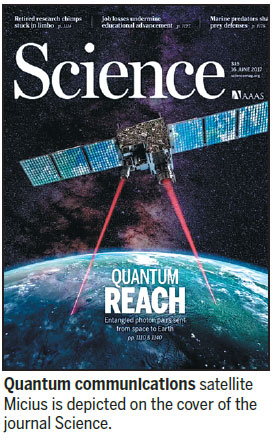China achieves a quantum jump

Photon tests are blazing a trail for ultrasecure, long-distance communication of the future
China has become the first country in the world to establish photon entanglement at a distance of more than 1,200 kilometers, paving the way for ultrasecure, long-distance quantum communication.
In July, Beijing and Vienna will try to conduct the world's first cross-continental video call using Micius, the world's first quantum communication satellite launched by China last year. It will take more than a decade for such technologies to reach the public, scientists say.
By beaming photons - individual particles of light - between Micius and two receiving ground stations, the Delingha station in Qinghai province and the Lijiang station in Yunnan province, Chinese scientists have shown that these photons could remain entangled despite the stations being more than 1,200 kilometers apart.
This distance is 10 times greater than similar tests done on the ground, which are usually conducted using fiber optics or in open air and are susceptible to interference, according to findings published on June 16 in Science, an international journal.
"This is the first major scientific discovery of Micius, and it proves the feasibility of satellite-based quantum communication," says Pan Jianwei, an academician at the Chinese Academy of Sciences and the chief scientist of the quantum satellite project.

"It will also provide reliable technological support for research in other fundamental science fields like relativity and quantum mechanics," he adds.
Quantum entanglement is a phenomenon in which two or more entangled particles can affect each other simultaneously, regardless of the distance between them. Albert Einstein called this interaction "spooky", but scientists are trying to use it to encrypt and send messages.
"This is the most secured method of communication, because any eavesdropper will disrupt the entanglement and be detected," says Wang Jianyu, a CAS researcher and the system commander of Micius.
Quantum communication will have significant applications in finance and military, where security is paramount, though it is still too early to say whether it will replace conventional methods, he adds.
The accurate transfer of photons between the sender and receiver is not easy, since the optical axis of the satellite must point precisely toward those of the telescopes on the ground. This means there is only about five minutes to experiment each night.
"This requires extremely precise measurement," says Wang. "Receiving the entanglement is like using a piggy bank to catch coins dropped from a plane."
Moreover, quantum entanglements cannot be amplified like radio signals, so scientists still need to overcome disturbances when delivering photon entanglement over thousands of kilometers.
Sophisticated devices called "quantum repeaters" could in theory be chained together to receive, store and retransmit the quantum data across longer distances, much like a cell tower, but this task is so difficult that such systems remain largely theoretical.
"It will still take more than a decade for the technology to reach the market," says Pan.
Other countries including the United States, the United Kingdom, Canada, Austria and Singapore are also pursuing quantum communication. Many of them are interested in cooperating with China.
"Micius and the quantum communication fields will be good platforms for large-scale, cross-disciplinary scientific research around the world," Pan adds.
Contact the writers at zhangzhihao@chinadaily.com.cn
(China Daily Africa Weekly 06/23/2017 page14)
Today's Top News
- Opening of new gateway can help foster global economic and trade cooperation
- The farmer, the snake and Japan's memory hole
- Crossing a milestone in the journey called Sinology
- China-Russia media forum held in Beijing
- Where mobility will drive China and the West
- HK community strongly supports Lai's conviction






























